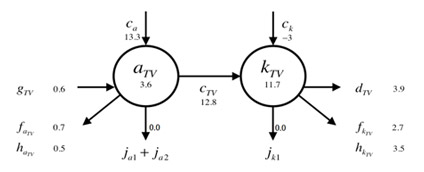Energetic Study of Intense Storms over Mid-Latitude Area: Application Using a Simulation of the Canadian Regional Climate Model (version 5 – CRCM5) over Eastern North America for December 2004
Submitter: Dr. Oumarou Nikiéma, UQAM/ESCER Centre
Area of Research: Atmospheric and climate dynamics
Journal Reference:
Clément, M., O. Nikiéma and R. Laprise, 2016. Limited-Area Atmospheric Energetics: Illustration on a Simulation of the CRCM5 over Eastern North America for December 2004. Climate Dynamics, pp. 1-22, 2016, doi:10.1007/s00382-016-3198-0.
Science:
The key sciences accomplished include (i) the development of a formalism suitable for the study of atmospheric energetics applicable over a limited region, and (ii) its application by studying the energy budgets of specific weather systems over a domain centered on the eastern portion of North America.
Impact:
Regional Climate Models (RCMs) are known to be a good tool that can be used to study the impacts of climate changes at regional scales. The present methodology allows studying the energetic characteristics of storms regarding their intensity, duration, occurrence, and spatial distributions at regional and synoptic scales since RCM simulations provide all variables required for such study.
Summary:
The scientific community agrees that we are already living with the effects of man-made climate change. In the future, extreme weather and climate events like storms in mid-latitude will change in terms of their frequency, duration, spatial extent, and intensity (IPCC 2014). It is, therefore, important to pay particular attention on atmospheric energy conversions taking place during the development of intense storms at the regional scale. Our methodology uses a decomposition of atmospheric variables into their time-mean state and time variability (perturbation) rather than into zonal-mean and deviations as is usually done for global energetics studies (Lorenz, 1955 & 1967).
Using data from a simulation performed with the 5th generation Canadian Regional Climate Model (CRCM5) driven by Era-Interim (Dee et al., 2011), we analyze the energetic characteristics of a particular intense storm that occurred in December 2004. Results reveal that this intense storm was produced by a well-known process called baroclinic conversion, by which its kinetic energy develops by conversion from Available Enthalpy (AE) of the background state (Lorenz, 1955 & 1967). Basically, the storm is clearly associated with a large temperature gradient anomaly that implies the existence of perturbation AE, which is converted to perturbations Kinetic Energy (KE) during the intensification of the storm. Some processes such as friction in the boundary layer contribute to dissipate the Kinetic Energy, indicating the decay and death of the storm.
In terms of perspective, this research can be extended to evaluate the impact of anticipated climate changes due to the continued release of greenhouse gases by anthropogenic activities. The comparison of current and future energy budgets could provide a general overview of how the local energetics should be expected to change under global warming.
Link to the Original Research Publication or Website:
http://link.springer.com/article/10.1007/s00382-016-3198-0


